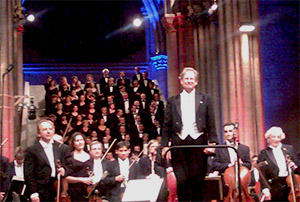|
|
|
| Après Daniel Harding, la semaine dernière, c’était cette fois Sir John Eliot Gardiner CBE FKC qui officiait hier soir à Saint-Denis. N’étant pas un fan des baroqueux et particulièrement pas de ses interprétations à l’ancienne du répertoire romantique, on était a priori content que ce soient les forces de l’Orchestre National de France qui soient réunies ce soir-là, avec l’appui du Monteverdi Choir.
Ce gentleman farmer anglais (95 têtes de vaches !) me faisait irrésistiblement penser au grand Duduche de Cabu… mais sa gestique claire et élégante nous a donné un superbe concert dans cette œuvre de 1837 finalement assez rarement donnée compte-tenu des effectifs requis. Passons rapidement au débit. On n’avait pas réécouté l’œuvre depuis des années, bercé dans notre jeunesse par la version Colin Davis – et regrettant alors de ne pas avoir les moyens d’acquérir la version Munch… Ceci pour dire que l’amateur peut voir son appréciation d’un concert brouillée voire annihilée par des plaisirs musicaux solitaires répétés… On a trouvé quand même que le Rex tremendae étant vraiment trop rapide et que le Lacrymosa n’était pas assez « posé ». Mais au global ce fut un vrai bonheur, ne serait-ce que d’entendre de vrais bons ‘décibels’ – Tuba mirum – non déformés ou compressés par un appareil de reproduction. Les interventions du Monteverdi choir sont proprement sidérantes : les Heifetz ou Rachmaninov du chœur ! Mention spéciale pour le Sanctus merveille d' »antiphonie » avec le – très bon – ténor Michael Spyres situé tout en haut devant l’orgue, la batterie à gauche, l’orchestre au centre et le chœur au fond. (ajoutons en guise de clin d’œil que Sir John déclarait dans une interview du début de l’été à Diapason que les Jeux de Londres seraient une catastrophe totale…) |
After Daniel Harding last week, Sir John Eliot Gardiner CBE FKC was conducting yesterday evening in Saint-Denis. Not being a fan of “baroque” interpretations and particularly not of his interpretations of the romantic repertory, we were happy to know that the forces of the National Orchestra of France were invited this evening, with the support of Monteverdi Choir.
This gentleman English farmer (95 cows!) showed a clear and elegant gesture and gave us a superb concert in this work of 1837. One had regretted the setting of the chorus in Schubert by Harding, this time it was worse: it was placed on a far tilted rostrum behind the orchestra, Monteverdi choir in the foreground, Radio France choruses behind, so that in many passages, the orchestra, very well sounding besides, covered it almost completely (balance will certainly be corrected during the recording edition). We hadn’t listened to this work for many years, rocked in our youth by the Colin Davis version – and then regretting not having the means of acquiring the Munch version… This for saying that the amateur can see his appreciation in a concert scrambled or even destroyed by repeated solitary musical pleasures… I found nevertheless that the Rex tremendae was really too fast and that Lacrymosa was not “posed” enough. But in the global it was a true happiness, especially to listen to big and beautiful sound – Tuba mirum – not deformed or compressed by a reproduction device. The interventions of the Monteverdi choir are properly striking: they are the Heifetz or Rachmaninov for the chorus! Special mention for the Sanctus: a wonder of “antiphonal” with the – very good – tenor Michael Spyres located in the air in front of the organ, the battery on the left, the orchestra in the center and chorus far away. (let’s add as a joke that, in an interview to Diapason at the beginning of the summer, Sir John declared that the London Olympic Games would be a complete catastroph…) |
Poor definition :

